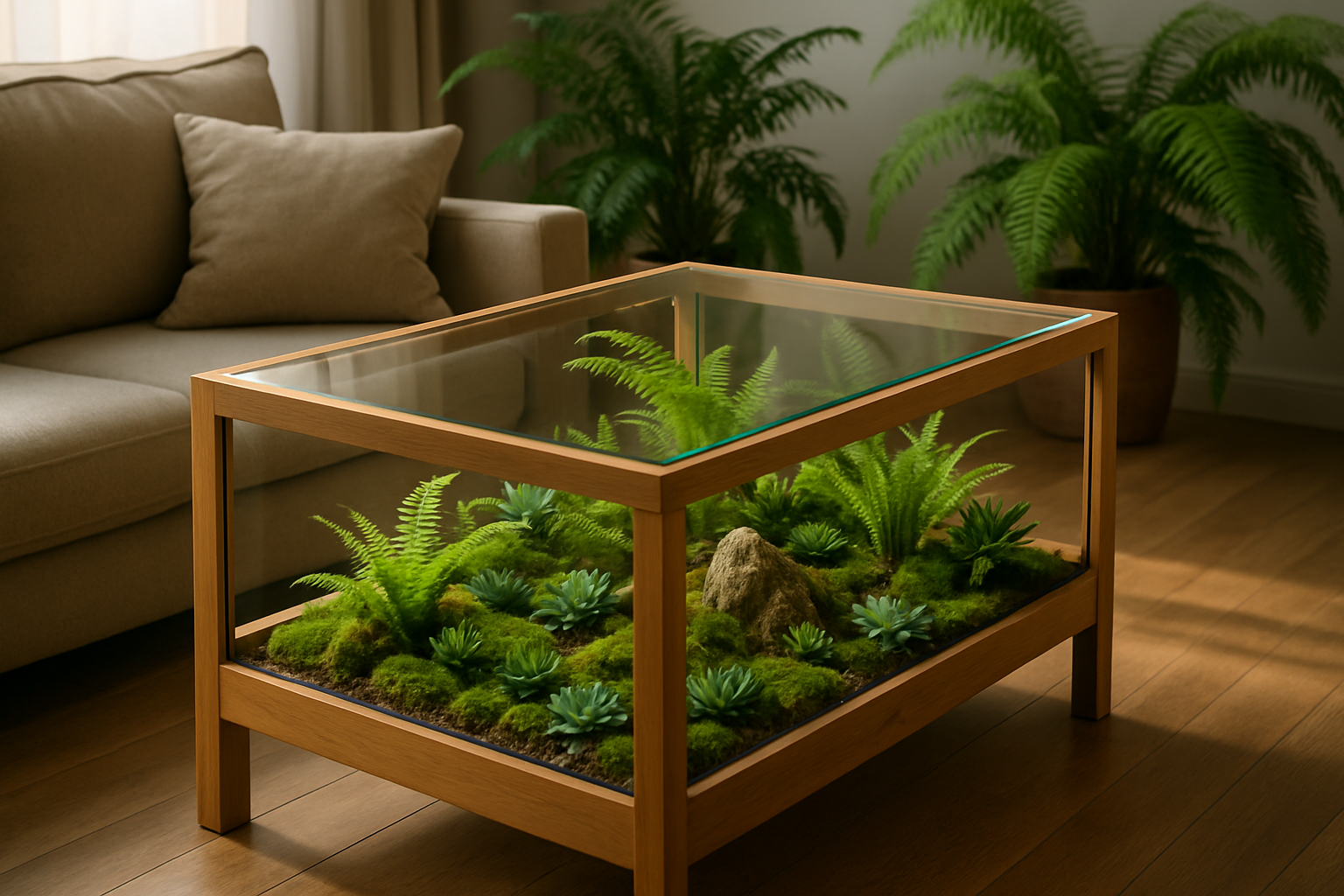Terrarium Tables: Living Furniture for Biophilic Homes
In a world where technology increasingly disconnects us from nature, terrarium tables emerge as captivating functional art pieces that bring wilderness indoors. These ingenious furniture designs combine the utility of everyday tables with vibrant miniature ecosystems thriving beneath glass surfaces. Unlike traditional terrariums that sit on surfaces, these integrated designs transform practical furniture into living displays that evolve and grow with time. The marriage of functional furniture with natural elements creates conversation pieces that serve multiple purposes in modern interiors. Whether housing succulents, mosses, or tropical plants, terrarium tables offer a fascinating glimpse into nature's processes while providing practical surfaces for daily life.

The Evolution of Living Furniture
Terrarium tables represent the fascinating intersection of botanical history and furniture craftsmanship. The concept traces back to Wardian cases of the Victorian era, sealed glass containers that protected exotic plants during long sea voyages. These early botanical experiments laid groundwork for modern terrariums, but their integration with functional furniture emerged only in recent decades. The 1970s houseplant boom saw early experiments with glass-topped plant displays, though these were primarily decorative rather than functional. Contemporary terrarium tables evolved from these beginnings, reimagined by designers seeking to address growing biophilic design trends while acknowledging space constraints in modern homes. What began as custom pieces from boutique designers has expanded into diverse offerings ranging from artisanal crafted models to accessible retail versions that democratize this unique furniture category.
Anatomy of the Perfect Terrarium Table
Successful terrarium tables balance horticultural requirements with furniture functionality through thoughtful construction. The foundation typically features a shallow basin ranging from 4-8 inches deep, constructed from materials that resist water damage such as marine-grade plywood, aluminum, or specialized polymers. This basin houses drainage layers of activated charcoal, gravel, and specialized terrarium soil that prevent root rot while maintaining proper moisture levels. The glass top requires careful engineering, featuring tempered safety glass thick enough to withstand daily use while remaining perfectly clear for viewing. Many designs incorporate ventilation systems—small, discreet openings that facilitate air exchange and prevent condensation buildup that would obscure views. Advanced models include integrated LED grow lights concealed within table frameworks, programmable watering systems, and removable glass sections that enable easy access for maintenance while preserving the furniture’s clean lines.
Plant Selection Strategies
The enclosed environment of terrarium tables creates unique microclimates that favor specific plant varieties. Slow-growing specimens with minimal height requirements perform best, preventing excessive maintenance and glass fogging. Miniature ferns like button ferns and maidenhair varieties thrive in these environments, their delicate fronds creating intricate textures without overwhelming the space. Fittonias with their distinctive veined leaves add vibrant patterns, while miniature peperomias offer architectural leaf structures in various colors. For drier terrarium settings, uncommon succulent varieties like haworthia cooperi with its translucent “windows” create stunning visual effects when viewed through glass. The emerging trend of miniature aquatic terrarium tables introduces another dimension, incorporating small water features with aquatic plants like anubias nana and microsword that create underwater landscapes. When selecting plants, consider growth rates, moisture requirements, and how their visual characteristics will appear when viewed from above—the primary viewing angle for these functional art pieces.
Maintenance and Care Techniques
Terrarium tables require specialized care that balances horticultural needs with furniture functionality. The sealed or semi-sealed environments create self-sustaining microsystems that require less frequent watering than conventional houseplants—typically monthly rather than weekly attention. Proper maintenance begins with strategic watering using long-neck watering tools that deliver moisture precisely where needed without splashing the glass underside. Pruning demands specialized tools including long-handled scissors and miniature gardening implements that can navigate through access points without disturbing the overall arrangement. Climate control presents unique challenges, as terrarium tables respond to ambient room conditions; positioning away from heating vents, air conditioners, and direct sunlight prevents temperature fluctuations that stress plants. Modern innovations include magnetic cleaning tools that allow owners to wipe condensation from unreachable inner surfaces and specialized plant food formulations developed specifically for closed terrarium environments that provide slow-release nutrients without encouraging excessive growth.
Design Integration in Contemporary Interiors
Terrarium tables serve as dynamic focal points that complement various interior styles through thoughtful placement and complementary elements. In minimalist spaces, these tables provide organic counterpoints to clean lines and monochromatic palettes, their contained greenery creating vibrant contrast without introducing visual clutter. Contemporary designs featuring metal frames with geometric angles pair exceptionally well with mid-century modern aesthetics, the transparent surfaces maintaining visual lightness essential to this style. Professional interior designers increasingly position terrarium tables adjacent to natural light sources where the glass elements create prismatic effects as sunlight filters through, casting ever-changing patterns throughout the day. The viewing experience transforms depending on perspective—standing positions reveal broad landscape views while seated arrangements offer intimate glimpses into miniature worlds. Advanced styling approaches incorporate seasonal rotations, switching plant palettes to reflect changing seasons and holidays without requiring entirely new furniture pieces. Their dual functionality makes them particularly valuable in smaller spaces where every piece must serve multiple purposes, functioning simultaneously as practical surfaces and dynamic living art.
Customization and Personal Expression
Beyond pre-fabricated options, terrarium tables offer exceptional opportunities for customization that reflect individual aesthetics and practical needs. The terrarium basin serves as a canvas for personal expression through themed plant collections, from moody moss-filled woodland scenes to bright tropical arrangements with flowering miniatures. Height-adjustable models solve practical challenges, transforming from coffee tables to dining surfaces as needed while maintaining their biophilic benefits. Creative enthusiasts incorporate miniature figurines, architectural elements, and seasonal decorations that create narrative tableaux beneath the glass, turning furniture into storytelling devices. Material combinations reflect personal style preferences—reclaimed wood bases paired with industrial metal frames create rustic modern statements, while lucite and glass constructions offer contemporary elegance. The growing maker movement has embraced terrarium table construction, with workshops teaching combined skills of woodworking, basic plumbing for drainage systems, and terrarium design principles, allowing enthusiasts to create completely personalized living furniture that perfectly complements their homes while expressing their unique relationship with nature.





